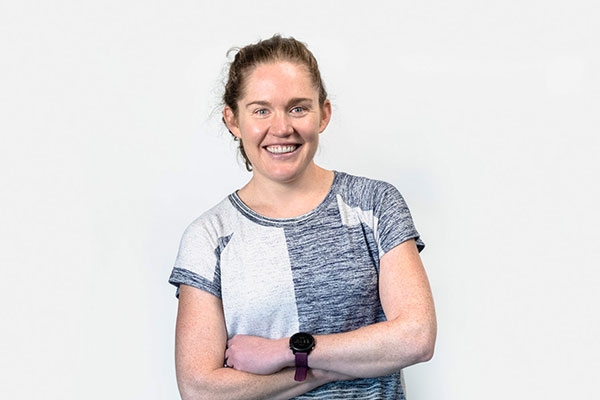WHAT CREATES A HIGH-PERFORMING BASKETBALL SHOE?
By  Dan Feeney
Dan Feeney  Kate harrison
Kate harrison
Follow on ![]() @Dfeeney31 and @running_geek
@Dfeeney31 and @running_geek

Quick Takes
- The goal of performance basketball shoes is to facilitate powerful cutting and jumping while reducing non-contact injury rate.
- Midsole stiffness, height of the collar, and foam durometer are all important considerations for the best basketball shoe for you.
- Despite incredible marketing, the shoes of your favorite NBA player may not be right for your position, playing style, and injury history.

Dan’s Take
I grew up playing basketball and I even ran my first cross country race in LeBron James suede basketball shoes. Clearly, I put fashion and the impact of marketing ahead of the best shoe for the activity. As a footwear researcher, I still see this happening today (although, usually basketball shoes are kept on the court rather than the mud). Anecdotally, we test many basketball players wearing the wrong size shoe (often they want a big size but not too big), and players using shoes that don’t match with their position or injury history. In contrast to running, there is not a ton of biomechanical research on basketball footwear, as most focuses on shooting technique, but we will dive into what we know and how we test.

Kate’s Take
As a late bloomer, I was never tall enough to play basketball outside of gym class growing up. I was in awe of those who excelled on the court – both for their ability to seemingly defy gravity, and for the personality of the shoes they wore while doing it. As a runner, I was coached to ignore aesthetics in favor of choosing those that fit that performed best – which usually meant something less than stylish. With research into basketball performance and injury risk rapidly progressing, I’d like to think we can bring an evidence-based performance mindset to meet the fashion-oriented design values, creating innovative footwear that provides the best of both worlds.

BOA’s Take
Fit is key to a shoe in which you will create sheer forces that are 2-3 times your body weight. When looking at basketball, we leverage findings from our Agility & Speed paper to create tests that are sensitive to fit. We have learned from this study that the BOA PerformFit™ Wrap can improve how quickly and powerfully athletes change direction relative to an identical shoe equipped with laces.

Research on the Topic
The first shoe made for basketball was the Converse All Star, introduced in 1917. While no longer worn on competitive courts, they are an off-court fashion staple to this day. Since then, advancements in biomechanics and injury research have led to the creation of more robust footwear. Today, shoes are designed with two primary functions in mind: to allow athletes to maximize performance, and to reduce injury risk. Basketball all-stars possess a combination of speed, agility, power, and endurance. With NBA and WNBA players being significantly taller and more muscular than the general population, their shoes are critical to performance since they can produce sheer forces of 3-4 times their body weight when changing direction (based on athletes in our lab), not to mention impact forces up to 9 times their body weight when landing from a layup. Zion Williamson has shown us that this sheer force can be used to juke an opponent or break a shoe and injure a knee. You may not be playing in the pros, but you can still pick the best basketball shoe for you by considering your position, playing style, and injury history.
Performance
Depending on your position, basketball shoes should allow you to move quickly so you can make a jump shot over a defender, pivot powerfully, and provide a foundation of support for boxing out your opponent to get rebounds. A key determinant of shooting accuracy in high-level performers (NCAA, NBA, etc.) is the ability to jump powerfully (reaching a high jump height quickly) (Struzik, 2014). Powerful movements allow you to avoid defenders and let the feedforward mechanisms that determine the mechanics of your jump shot to take over. The ability to move powerfully also contributes to agility performance (such as time to complete a triangle drill), which is a key predictor of overall game performance, as measured by the Performance Index Rating.
Traction, weight, and stiffness are a few of the design elements used to tune the performance of a basketball shoe. While a common solution to improve player performance is to reduce shoe weight, too minimal of a shoe can result in decreased economy (it takes more energy to move at a given pace) or increased injury risk. A study released in March, 2021 showed that athletes could change direction in lateral cutting maneuvers with less ankle work with TPU-reinforced uppers. With our first Agility & Speed study, we demonstrated that more attention should be provided to the upper when designing a high-performance basketball shoe; with wrapping fit configurations, time to complete a movement decreased by 3-7% which could make the difference between a buzzer-beater 3-pointer versus a blocked shot. Taken together, these studies show that reinforcing the upper and providing a performance fit can substantially improve athlete performance.
Injury
Of course, to make these types of glory shots, an athlete needs to be in the game. Alas, ankle sprains, knee ligament tears, and metatarsal fractures are common non-contact basketball injuries. An estimated 48- percent of injuries in basketball occur without contact to another player; this happens when the player’s body moves in a way that causes injury (e.g. an ACL tear from a landing or cut). There is no surefire way to prevent injury, but footwear brands add a variety of technologies to shoes in an attempt to reduce injury risk. Most knee injuries stem from cutting movements where the foot is placed firmly under high forces, while more proximal (closer to the head) limbs and joints move forcefully in another direction, causing bending or twisting at the knee joint beyond the capacity of the ligaments.
The primary method of sprain comes from a sudden inversion (bottom of the foot turns inward) coupled with internal rotation (rotating the toes toward the midline) and plantarflexion (pointing the toes down) (Panagiotakis, 2017). This movement pattern often results when a player suddenly changes direction to evade an opponent, is knocked around while landing from a jump, or lands on an irregular surface (often on top of another player’s foot). While players need to be nimble enough to change direction powerfully, mid-cut shoe collars can provide a bit more stability and proprioception to help prevent ankle sprains for those at a high risk. Lastly, metatarsal fractures occur at relatively high rates in basketball players, which is often attributed to the long feet of players creating a large moment (rotational force) at the metatarsal phalangeal joint.
There are multiple solutions that address these three common areas of injury. The use of softer midsole materials aims to improve how softly a player can land, mid-cut shoe collars are used to improve ankle stability, and specific outsole patterns with tacky traction coupled with robust uppers are used to keep the foot firmly planted on the midsole (Lam, 2019). For players with a history of stress fracture, stiffer midsoles can increase ankle joint motion and reduce motion at the metatarsal phalangeal (MTP – the ball of your big toe) joint, which can reduce plantar forces (Taylor, 2019). On the other hand, if you suffer from ankle instability, a mid-cut, less stiff shoe could take some stress off that joint (but don’t forget, your ankle control and strength work is critical too). Aside from shoes alone, ankle braces can reduce these ankle injuries prophylactically. In addition, evidence suggests that better proprioception – an athlete’s ability to sense their joints’ position in space – is associated with reduced injury risk and can be enhanced by techniques that provide tactile feedback, such as taping.

How we test
During the development process, we test 5-6 basketball players in order to gain confidence in how a solution will perform and compare the results to our 31 person validation study. In our lab, players perform four movements: skater jumps, countermovement jumps, triangle drop step drill, and an anterior-posterior jab-step drill. We repeat these drills in each shoe configuration under consideration. Each time the athlete hits the force plate, we calculate how quickly they change direction, how quickly they produce force during the propulsive phase of movement, and how much total mechanical work is required to execute the drill. We find that the best fitting shoes can improve all three of these measurements – and we bring these to market with confidence that players will see the benefit in their game.
For athletes, coaches, and retailers
A lot of people buy shoes based on their favorite basketball star or what looks the best, but research shows that shoes can be important for performance and injury prevention. For a point or shooting guard, a shoe with a stiffer mid and forefoot could aid in running up and down the court, so search for a shoe where running feels smooth and efficient while still allowing you to cut and change direction quickly and powerfully. For centers and power forwards, look back at your injury history and playing style; a mid-cut shoe or an ankle brace could help if you want a little extra support for your ankles in unpredictable playing situations.
If space is available in the store, athletes should do some common agility movements in the shoes. This can give them a good impression of how the shoe will handle when moving in a game. We often see moderate to strong correlations between subjective feedback on shoe fit with how the product impacts athlete performance.
Remember, your shoes are more than a fashion statement – the technology that goes into shoe design can have an important impact on your performance and ability to stay healthy. Taking some time to figure out what your specific needs are will give you an edge on the court.
We can be found on Twitter @Dfeeney31 and @running_geek.